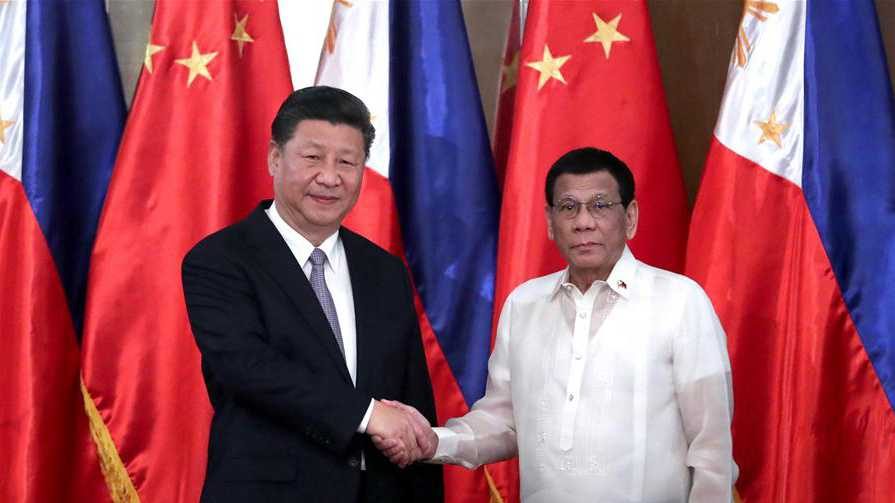
Opinions
23:13, 21-Nov-2018
Opinion: China, Philippines embrace 'rainbow after the rain' with upgraded ties
Updated
22:23, 24-Nov-2018
Li Linxi

Editor's note: The article is based on an interview with Dai Fan, a Southeast Asian affairs expert and a professor at the School of International Studies at Jinan University. The article reflects the expert's opinion, and not necessarily the views of CGTN.
Describing ties with the Philippines as "rainbow after the rain," Chinese President Xi Jinping concluded a two-day state visit to the archipelagic country on Wednesday, his first after taking office in 2013, and the first of its kind by the Chinese head of state since 2005.
Ahead of the visit, President Xi said in a signed article that he expected the trip will bring the bilateral ties to a higher level.
Within hours after his landing in Manila, Xi and his Philippine counterpart Rodrigo Duterte announced to elevate the Sino-Philippine relations into one of comprehensive strategic cooperation.
On Wednesday, the two countries published a joint statement, stipulating cooperation on Belt and Road construction and agreeing to discuss maritime cooperation.
"The upgraded ties show the two countries are viewing each other as a vital partner," Dai Fan, a Southeast Asian affairs expert from Jinan University, told CGTN.
"For the Philippines, it is in a strong need to develop the economy and improve the infrastructure. It welcomes investments from all sides, especially from China. For China, it wants to build stabilized ties with Manila when the territorial dispute over the South China Sea has become a crucial problem afflicting it and its Southeast Asian neighbors," Dai added.
The two leaders also witnessed the signing of 29 memoranda of understanding (MoUs), ranging from trade and finance to agriculture and infrastructure, culture and people-to-people exchanges, as well as oil and gas development.
"If the MoU on the oil and gas cooperation can introduce real results, that will set an example for other countries in solving the South China Sea dispute," Dai Fan said.

President of the Philippines Rodrigo Duterte arrives at a hotel in Beijing, China, October 18, 2016. /VCG Photo
President of the Philippines Rodrigo Duterte arrives at a hotel in Beijing, China, October 18, 2016. /VCG Photo
Relations between China and the Philippines have rebounded under the administration of Duterte. Unlike his predecessor, Benigno Aquino III, who initiated an international arbitration case against China's claims in the South China Sea in 2013, which brought ties to their lowest point since they were established in June 1975, Duterte describes Beijing as a friend and development partner.
In his state visit to China in October 2016, he declared the Philippines' “realignment” with China. Beijing and Manila signed deals worth 24 billion U.S. dollars.
Exchanges between the two countries have increased since then. The two presidents have met six times on both bilateral and multilateral occasions.
Last year, trade volume between China and the Philippines topped 50 billion U.S. dollars, making Beijing Manila's top trading partner, export market, import origin, as well as the second largest source of tourists.

Philippine President Rodrigo Duterte (3-R) speaks during his bilateral meeting with Chinese President Xi Jinping (not pictured) during the Belt and Road Forum, at the Great Hall of the People in Beijing, May 15, 2017. /VCG Photo
Philippine President Rodrigo Duterte (3-R) speaks during his bilateral meeting with Chinese President Xi Jinping (not pictured) during the Belt and Road Forum, at the Great Hall of the People in Beijing, May 15, 2017. /VCG Photo
Yet there are concerns. Some questioned why the amount of Chinese investment in the Philippines is relatively small, compared with those of the United States and Japan.
"In terms of overseas investment, we need to admit China is relatively a novice in this regard, compared with the U.S. and Japan, which started investing in the Philippines decades ago," said Dai Fan, "Chinese companies are still in a globalization process. And the projects they invested in the Philippines are mostly infrastructure-related ones, which take time to see the effects."
"But if you look at the growth rate of China's investment in the Philippines, you will see the momentum is good," said Dai, "and that trend is expected to continue."
The newly added investment from China reached 53.84 million U.S. dollars, representing a year-on-year increase of 67 percent.
"Now more work needs to be done in building public trust in China, which requires involvement not only from governments, but also from people, and other institutions such as media," Dai added.
With a joint statement and 29 MoUs as guidance for future cooperation, we have every reason to believe the bilateral relations will be further boosted and serve as a new model of international relations.
(Cover photo: Chinese President Xi Jinping holds talks with his Philippine counterpart Rodrigo Duterte in Manila, Philippines, November 20, 2018. /Xinhua)
(If you want to contribute and have specific expertise, please contact us at opinions@cgtn.com)

SITEMAP
Copyright © 2018 CGTN. Beijing ICP prepared NO.16065310-3
Copyright © 2018 CGTN. Beijing ICP prepared NO.16065310-3